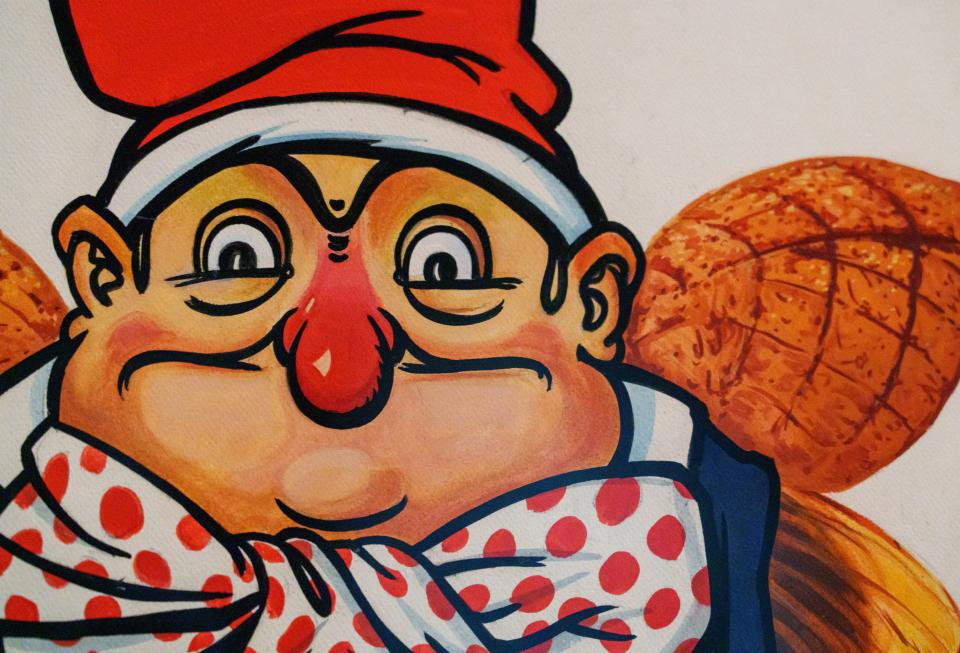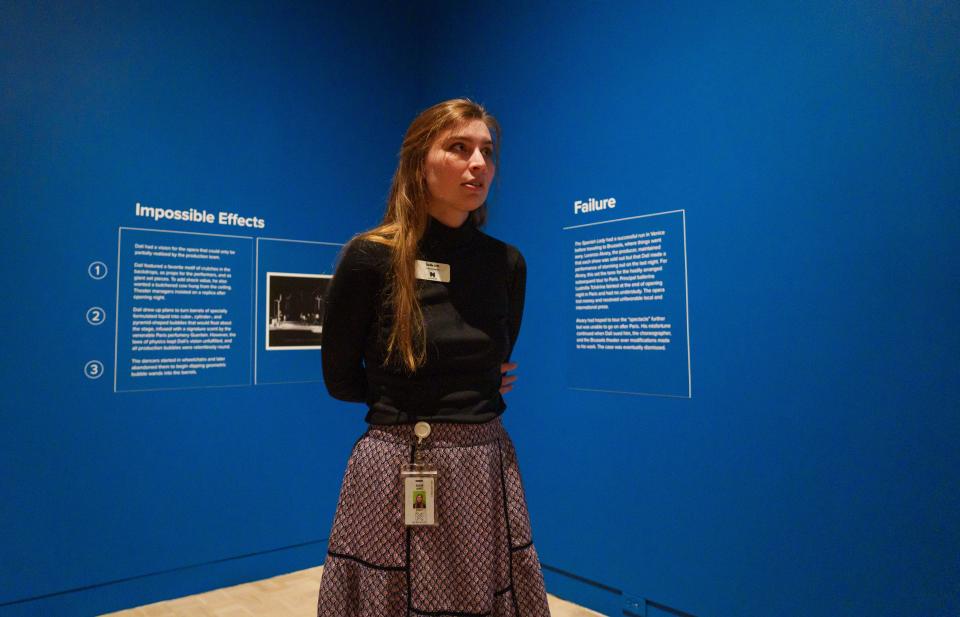How did 4 Dalí paintings — displayed now for the first time since 1979 — end up at Newfields?
- Oops!Something went wrong.Please try again later.
The story of Salvador Dalí's work on "The Spanish Lady and the Roman Cavalier" began with great fanfare. The 1961 opera married the artist's whimsical set designs — including spindly-legged elephants, a cracked cello-butterfly creature and melting clocks — with a surreal series of events on stage.
By the end of "The Spanish Lady's" run, however, Dalí had demanded the inclusion of raw meat in performances, become frustrated with perfumed bubbles that defied his vision and sued the producer.
The keeper of that story for the past half-century has been the Indianapolis Museum of Art at Newfields — the first of a few surprising Hoosier connections to the European opera. Between 1973 and 1975, the producer and lead, Lorenzo Alvary, and his wife gifted the museum four watercolors by Dalí that had been used for the set designs. Lorenzo was a veteran Metropolitan Opera bass who often sang at Indiana University. Before marrying him, Hallie Fox Alvary had resided in LaPorte for almost 40 years as the wife of a wealthy industrialist.
Embedded in that story are a few mysteries. A fifth painting exists, but curators don't know its location. They also don't have documentation as to why, exactly, the watercolors landed at the Indianapolis Museum of Art in the first place.
"We were able to reach into our print storage and find pieces that that could tell us an aspect of Dalí's story that wasn't represented," said Anna Stein, associate curator of works on paper.
The remaining four paintings are being shown together for the first time since 1979 — a rotation all the more high-profile thanks to their position inside the Lume's new "Dalí Alive." The multisensory cinematic experience sets animated images from the artist's work to a soundtrack and a spicy, earthy scent across three fourth-floor galleries.
What 'The Spanish Lady and the Roman Cavalier' was about
Lorenzo Alvary was aiming for a spectacle when he began production of "The Spanish Lady and the Roman Cavalier." At least by that measure, according to accounts at the time, he was successful.
The plot centered on a series of flirtations between said lady and said cavalier. Alvary's collaborator, the musicologist Giulio Confalonieri, assembled the work by stringing together comic scenes that had originally been diversions interspersed throughout the 1714 opera "Scipione nelle Spagne" by iconic Italian composer Alessandro Scarlatti.

'Dalí Alive' at Newfields: What to know about the new Lume feature, ticket info and more
The producers added to the mix a new ballet called "Gala" and asked Dalí to create costume and set designs — which included the five watercolors. The museum's works show his dynamic colors and symbols working together to form a dreamlike scenes with aren't expected to be juxtaposed, like a car in a tree or a tree blowing a horn.
Dalí's "name was a drawing factor for people to come see this," Stein said.
The opera premiered in August 1961 in Venice before heading to Brussels and Paris. And performances offered a feast for the senses. The orchestra and conductor wore 18th-century costumes. On stage, a chambermaid ironed a large nightgown, and men wearing surgical bandages tore off statues' arms and ate them, as Everett Helm wrote in the October 1961 edition of "The Musical Times."
Dalí himself ran onto the stage to throw paint around. It hit a canvas, his own gondolier's costume and several photographers who later demanded damages for their suits.
No one, it seems, comprehended what was going on.
"What does all this hocus-pocus add up to—art, sensationalism or just good clean, wholesome fun?" Helm wrote. "It is difficult to say, because there is no satisfactory frame of reference."
At the Paris debut, some in the audience chanted "we want our money back" while others cheered and whistled.
More: Newfields' handling of CEO's exit is 'an unforced error' eroding public trust, experts say
And as a gallery wall quotes Dalí: "I don't understand it myself."
But the silly mood was soon dampened.
Raw meat and square-ish bubbles herald the end of the partnership
Beef and bubbles were among the ensuing frustrations. Dalí had insisted on hanging from the ceiling a raw side of the meat, which had been purchased the morning before and transported to the theater in the stage manager's "now-bloody" car, Robert Alden wrote in a special to the New York Times about the 1962 Paris debut. Management later decided on a cardboard replica, Stein said.
What's more, Dalí had designed stage props intended to create square-, cylinder- and pyramid-shaped bubbles that would hover over the performances. He'd been testing them in the U.S. four months before the Venice debut but without luck.
"Bah!" the artist told the New York Times in April 1961. "That is American over-technicalization for you. One of your great chemical companies made this solution for us. They order these things better in France, where in a test my soap bubbles lasted one month."
But the French bubbles refused to submit, too. Reviewers struggled to assess whether a particular night's bubbles were indeed more cube-shaped, Stein said.

Dalí sued Alvary and others involved in the production because he believed his designs were misused, curatorial assistant Sadie Arft said, and a French court dismissed the case. Although Alvary intended to take "The Spanish Lady" to London and New York, the opera's initial run ended in 1962 in Paris, Arft wrote in a companion article for the Lume.
How Dalí paintings found their way to Indiana
Just two years before "The Spanish Lady" premiered, Lorenzo Alvary married Hallie Carr Fox Alvary. With much fanfare, Indiana newspapers reported that the Hungarian-born vocalist had met the "millionaire's widow" in Europe, and the two were married in LaPorte.
Both before and after meeting Hallie, Lorenzo had traveled to Bloomington multiple times to perform at the School of Music with other Met Opera singers.
Hallie herself had deep roots in LaPorte, having lived there for almost 40 years after she wed Norman J. Fox, whose family owned Fox Woolen Mills and made large civic contributions to the city. She was an arts patron who was interested in Midwestern cultural institutions, the Indianapolis Star reported in 1975. Hallie died in 2003 at age 102; Lorenzo died in 1996 at age 87.
That interest, curators said, may well have been why the Alvarys decided to donate "Tragedy and Comedy," "The Elephants," "Apotheosis" and "Musicians" to the Indianapolis Museum of Art. Arft said she didn't find documentation explaining the motivation behind the gift.
"It's kind of a fun narrative," Stein said of the opera. "I think the ups and downs and the successes and failures of the opera tell this great, kind of human story."
Newfields 'Dalí Alive': If you go
Where: The Lume at Newfields, 4000 Michigan Road
When: Open through early 2025
Cost: $29 adults, $25 ages 55 and up, $20 ages 6-17. Free ages 5 and under. Members receive discounts.
Tickets and more information: discovernewfields.org
Looking for things to do? Our newsletter has the best concerts, art, shows and more — and the stories behind them
Contact IndyStar reporter Domenica Bongiovanni at 317-444-7339 or d.bongiovanni@indystar.com. Follow her on Facebook, Instagram or Twitter: @domenicareports.
This article originally appeared on Indianapolis Star: Newfields' Dalí Alive: Paintings in the Lume have Indiana ties

